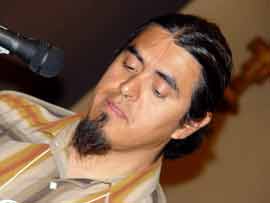|
QUINQUENNIAL CONGRESS XVII, PITTSBURGH, PA * U.S. SECULAR FRANCISCAN ORDER |
Images of Francis Bring Charism to Life
|
By MARY and BOB STRONACH, SFO Take a sheet of paper and fold it into four equal quarters; then, draw three of your most appealing images or words of Francis. Finally, ask yourself, “What is it about these images or words that I find most appealing and why? How does it relate to the Franciscan charism as I live my life today?” In a workshop entitled “Francis, Divine Providence and Our Secular Life,” Javier Orozco, SFO, a chaplain at DePaul University, took three images, as examples, to demonstrate how Francis lived the Gospel in his own time and allowed the Lord to use him to do His will. He further applied them to the theme of the Quinquennial Congress as a “way for us to view our reality and the tapestry of multiculturalism.” Image 1: Lepers were not among Francis’ early friends. They were among the marginalized and, as a merchant, there was no profit in associating with them. Soon after his conversion, however, they became among his most significant companions. They became the key instruments of God for Francis to know himself and the will of God. As Francis said, “The Lord led me to them and I showed them mercy.” It was the Lord who initiated the process. The experience with the lepers provides some profound spiritual lessons, noted Javier. It challenges us to “re-examine our patterns to move us away from biases…and sin…Francis had to open himself to that most foreign to him…but it was in their midst that communion emerged.” Divine Providence is the catalyst that brings Francis to the marginalized. He dares to say yes and with this choice, he is drawn closer to himself, others and to God, said Javier. “’Kissing’ became the human act shining God’s work through us.” Image 2: Francis returns all to his earthly father, even his clothes. He stands naked before the bishop who embraces him and covers him with his own cloak. Symbolically, Francis “empties himself…humbles himself and becomes obedient to the point of death,” noted Javier. “Francis and Jesus both stand …obedient in front of God. …The bitterness of the cup transcends familial connections.” As Francis faced challenges in making his choice – family or the will of God, we, too, today are challenged in the fractured credibility of the church. The issues are complex: sexual orientation, ordination of women, war and peace, immigration, living the life of poverty, liturgical norms, economic reform, sexism. We too must make choices. The Bishop, in embracing Francis, perhaps, represents the “best ecclesiology.” It is the place of grace and hope. Francis comes to the Bishop on account of a voice he hears. He goes to the bishop as a believer, to be assured that he is on the right path. And the bishop lovingly accepts him, “recognizing what is good.” “Spiritually listening is a priority,” said Javier. “Unresolved issues and resentments are attended to with listening hearts.” The bishop represents the church, he said, “ready to charge us with a renewed sense of freedom. And (like Francis) we are standing, ready to embark on a lifelong journey.” Image 3: While on his pilgrimage, Francis was robbed, stripped of his clothes and thrown in a ditch. This was not a “glamorous pilgrim’s life,” noted Javier, but, what did Francis do? He joyfully jumped out of the ditch, shook off the snow and announced to the robbers, “I am the herald of the great king.” “It is important to hold on to the spiritual and redemptive benefits of suffering,” as Francis did, noted Javier. “As Franciscans, we share a common identity as heralds, taking gospel to life and life to gospel,” in order to bring transformation. It should be our desire to go beyond the wall to the lepers and the sultan, and beyond our social and political comfort zone. Since we are in the world, holiness must occur in the very heart of the public arena, noted Javier. “There is no transformation without the muck of the world.” Our pilgrim agenda must be made public, whether it is family, work, peace and justice or ecological witness. Human freedom stems from knowing who we are as Christians and Franciscans and, like Francis, we must “herald” the message and speak from our perspective. “A Franciscan vocation is a public vocation – for and in the world,” noted Javier. Then, he challenged, “What walls in your life are keeping you from those who need you the most? What awaits beyond the wall?” ###
|
|

